Multiproxy Petrological Analysis for Provenance Determination of Two Granitic Stone Anchors in the Western Mediterranean
Abstract
1. Introduction
2. Geographical and Archaeological Context
3. Materials and Methods
4. Results
4.1. Petrographic Characterisation
4.2. Mineralogical and Geochemical Characterisation
4.3. Rock Age Assessment (K–Ar Method)
5. Analysis of the Provenance of the Lithic Anchors
- (1)
- (2)
- Given the inherent mobility of the artifacts (stone anchors), the potential provenance area must encompass the entire Mediterranean coastline.
- (3)
- Considering the relatively low degree of craftsmanship and the functional nature of these anchors, reducing production costs prevailed over the importation of high-quality materials from distant inland sources. To minimize production and transport expenses, the stone was likely sourced near the consumption area. In this context, coastal granite outcrops represent the most plausible sources.
6. Conclusions
Author Contributions
Funding
Data Availability Statement
Acknowledgments
Conflicts of Interest
References
- Tripati, S.; Mudholkar, A.; Vora, K.H.; Ramalingeswara Rao, B.; Gaur, A.S. Geochemical and mineralogical analysis of stone anchors from west coast of India: Provenance study using thin sections, XRF and SEM-EDS. J. Archaeol. Sci. 2010, 37, 1999–2009. [Google Scholar] [CrossRef]
- Beltrame, C.; Lazzarini, L.; Antonelli, F. A Roman shipwreck with a cargo of Apuan marble (marmor lunense) at Punta del Francese (Stintino-Sassari, Sardinia). Archaeometry 2020, 62, 1081–1094. [Google Scholar] [CrossRef]
- Fournier, F.; Leonide, P.; Marie, L.; Quillevere, F.; Margerel, J.P.; Miholjek, I.; Dugonijic, P.; Carre, M.B.; Cavassa, L.; Morsilli, M.; et al. Provenance of the ballast stones from the Roman Republican ship Ilovik-Paržine 1: A hypothesis about its place of construction. J. Archaeol. Sci. Rep. 2024, 57, 104580. [Google Scholar] [CrossRef]
- Yamasaki, M. Bronze Age stone anchors as material metaphor: Applying conceptual blending theory to investigate their symbolic value. J. Archaeol. Method Theory 2024, 31, 1272–1291. [Google Scholar] [CrossRef]
- Raban, A. Three-hole composite stone anchors from a medieval context at Caesarea Maritima, Israel. Int. J. Naut. Archaeol. 2000, 29, 260–272. [Google Scholar] [CrossRef]
- Hristov, I. Antique Stone Anchors, Stone and Lead Anchors Stocks from the Collection of the National Museoum of History; End of 2nd ML B.C.—3rd century A.D. Varna (Bulgaria); UNICART: Varna, Bulgaria, 2013. [Google Scholar]
- Warburton, D.A. Mediterranean stone anchors: Bronze Age tarde and social practice. J. Anc. Stud. 2020, 7, 193–211. [Google Scholar] [CrossRef]
- Toth, J.A. Composite stone anchors in the ancient Mediterranean. Typology, chronology and their rtole in the reconstruction of ancient trace. A proposal. Acta Arch. Acad. Sci. Hung. 2002, 53, 85–117. [Google Scholar]
- Parker, A.J. Ancient Shipwrecks of the Mediterranean and the Roman Provinces; Oxford University Press: Oxford, UK, 1992. [Google Scholar]
- Wachsmann, S.; Kahanov, Y.; Hall, J. The Tantura B Shipwreck: The 1996 INA/CMS Joint Expedition to Tantura Lagoon. INA Quartely 1997, 24, 3–15. [Google Scholar]
- Purpura, G. Un relitto di età normanna a Marsala. Archeol. Subacquea 1985, 29, 128–136. [Google Scholar]
- Fernández, D. Anclas líticas de tres agujeros en Galicia. In Actas del I Congreso de Arqueología Náutica y Subacuática Española; Nieto, F.X., Bthencourt, M., Eds.; Servicio de Publicaciones de la Universidad de Cádiz: Cartagena, Spain, 2013. [Google Scholar] [CrossRef]
- Nissenbaum, A.; Carmi, I.; Hadas, G. Dating of ancient anchors from the Dead Sea. Naturwissenschaften 1990, 77, 228–229. [Google Scholar] [CrossRef]
- Hadas, G.; Liphschitz, N.; Bonani, G. Two ancient anchors from Ein Gedi, on the Dead Sea, Israel. Rev. Int. De Arqueol. Náutica 2005, 34, 299–307. [Google Scholar] [CrossRef]
- Oron, A.; Hadas, G.; Liphschitz, N.; Bonani, G. A New type of composite anchor dated to the Fatimi-Crusader period from the Dead Sea, Israel. Int. J. Naut. Archaeol. 2008, 37, 295–301. [Google Scholar] [CrossRef]
- Hadas, G.; Segal, I.; Yofee, O.; Stein, M. Study of Roman anchor from the Dead Sea shore. Arqueometría 2009, 51, 1008–1014. [Google Scholar] [CrossRef]
- Frost, H. Ports, Cairns and Anchors. A Pharaonic Outlet on the Red Sea. Topoi 1996, 6, 869–902. [Google Scholar] [CrossRef]
- Benito Dominguez, A. Aproximación a la historia de las anclas lítica a partir de las recuperadas en al costa gipuzkoana. Itsas Memoria. Rev. De Estud. Marítimos Del País Vasco 2000, 3, 665–684. (In Spanish) [Google Scholar]
- Matés, J.M. El ancla lítica de tres orificios de la playa de Karraspio (Mendexa, Bizkaia). Kobie Ser. Paleoantropol. 2015, 34, 283–300. (In Spanish) [Google Scholar]
- Pérez Burgos, J.M. Nueva Tabarca. Patrimonio Integral en el Horizonte Marítimo. Ph.D. Thesis, Alicante University, Madrid, Spain, 2017. Available online: https://rua.ua.es/dspace/handle/10045/73330 (accessed on 11 February 2025). (In Spanish).
- Azuar, R.; Lajara, J.; Inglese, O. Informe Preliminar de la Prospección Arqueológica Subacuática en el Área Exterior de la Reserva Marina de la Isla de Nueva Tabarca. 2ª Fase de la Actuación de la Carta Arqueológica del Patrimonio Subacuático de la Provincia de Alicante (2012–2016). Unpublished Technical DocumentAlicante, Spain. 2012. Available online: www.marqalicante.com/contenido/publicaciones/2410045 (accessed on 10 October 2021). (In Spanish).
- López Rosendo, E.; Lorrio Alvarado, A.J.; Torres Ortiz, M. Hallazgos Protohistóricos de Procedencia Subacuática del Sur de la Provincia de Alicante y la Navegación de Época Colonial. In Carta Arqueológica Subacuática de Alicante II: El Sinus Ilicitanus (Santa Pola / Tabarca—Pilar de la Horadada, Alicante) Siglos V a.C.–XIX d.C.; Azuar, R., Inglese, O., Eds.; Instituto Alicantino de Cultura “Juan Gil-Albert”: Alicante, Spain, 2022; pp. 159–187. [Google Scholar]
- Molina Vidal, J.; Lorrio Alvarado, A.J.; Moya Montoya, J.A.; Lozano Quijada, F.; Corbí Sevila, H.; Martínez-Martínez, J.; Pérez Prefasi, A.; Pérez Burgos, J.M. Stone anchors from the Els Farallons underwater site on the Island of Nueva Tabarca (Alicante, Spain). SAGVNTVM Papeles Del Lab. Arqueol. Valencia, 2025; in press. [Google Scholar]
- Briggs, L.; Campbell, P.B. Shipwreck archaeology in the past 10 years. Archaeol. Reports 2023, 69, 131–145. [Google Scholar] [CrossRef]
- Debon, F.; Le Fort, P. A chemical-mineralogical classification of common plutonic rocks and associations. Trans. R. Soc. Edinb. Earth Sci. 1983, 73, 135–149. [Google Scholar] [CrossRef]
- Corsaro, R.A.; Cristofolini, R.; Pezzino, A.; Sergi, A. Evidence fro the provenance of building stone of igneous origin in the Roman Theatre in Catania. Period. Mineral. 2000, 69, 239–255. [Google Scholar]
- Enginoglu, S.; Ay, M.; Çagman, N.; Tolun, V. Classification of the monolithic columns produced in Torad and Mysia Region ancient granite quarries in northwestern Anatolia via soft decision-making. Bilge Int. J. Sci. Tech. Res. 2019, 3, 21–34. [Google Scholar] [CrossRef]
- Poli, P.; Tommasini, S. A geochemical approach to the evolution of granitic plutons: A case study, the acid intrusion of Punta Falcone (northern Sardinia, Italy). Chem. Geol. 1991, 92, 87–105. [Google Scholar] [CrossRef]
- Cirrincione, R.; Fiannacca, P.; Ortolano, G.; Pezzino, A.; Punturo, R. Granitoid stones from Calabria (Sourthern Italy): Petrographic, geochenical and petrophysical characterization of ancient quarries of Roman Age. Period. Mineral. 2013, 82, 41–59. [Google Scholar]
- González-Esvertit, E.; Casas, J.M.; Canals, A.; Bons, P.D.; Prieto-Torrell, C.; Cofrade, G.; Gomez-Rivas, E. Multi-Scale Analysis of the Mylonitized Giant Quartz Veins of the Cap de Creus and Canigó Massifs (Pyrenees). In Recent Research on Sedimentology, Stratigraphy, Paleontology, Geochemistry, Volcanology, Tectonics, and Petroleum Geology. MedGU 2022. Advances in Science, Technology & Innovation; Çiner, A., Naitza, S., Radwan, A.E., Eds.; Springer: Cham, Switzerland, 2024. [Google Scholar] [CrossRef]
- Carreras, J.; Losantos, M.; Palau, J.; Escuer, J.; Muñoz de la Fuente, J.A.; Barnolas, A. Mapa Geológico de España 1:50.000. Hoja 259. Memoria y Mapa; Instituto Geológico y Minero de España: Madrid, Spain, 1994; 37p. [Google Scholar]
- Druguet, E.; Castro, A.; Chichorro, M.; Pereira, M.F.; Fernández, C. Zircon geochronology of intrusive rocks from Cap de Creus, Eastern Pyrenees. Geol. Mag. 2014, 151, 1095–1114. [Google Scholar] [CrossRef]
- Duchesne, J.C.; Liégeois, J.P.; Bolle, O.; Vander Auwera, J.; Bruguier, O.; Matukov, D.I.; Sergeev, S.A. The fast evolution of a crustal hot zone at the end of a transpressional regime: The Saint-Tropez peninsula granites and related dykes (Muares Massif, SE France). Lithos 2013, 162–163, 195–220. [Google Scholar] [CrossRef]
- Peacock, D.P.S.; Williams-Thorpe, O.; Thorpe, R.S.; Tindle, A.G. Mons Claudianus and the problem of the ‘granito del foro’: A geological and geochemical approach. Antiquity 1994, 68, 209–230. [Google Scholar] [CrossRef]
- Rochette, P.; Ambrosi, J.P.; Amraoui, T.; Rieu, V.; Badie, A.; Borgard Ph Gattacceca, J.; Hartmann-Virnich, A.; Panneau, M.; Palnchon, J. Systematic sourcing of granite shafts from Gallia Narbonensis and comparison with other western Mediterranean areas. J. Archaeol. Sci. Reports 2022, 42, 103372. [Google Scholar] [CrossRef]
- De Vecchi, G.; Lazzarini, L.; Lünel, T.; Mignucci, A.; Visona, D. The genesis and characterisation of ‘Marmor Misium’ from Kozak (Turkey), a granite used in antiquity. J. Cult. Herit. 2000, 1, 145–153. [Google Scholar] [CrossRef]
- Pe-Piper, G.; Kotopouli, C.N.; Piper, D.J.W. Granitoid rocks of Naxos, Greece: Regional geology and petrology. Geol. J. 1997, 32, 153–171. [Google Scholar] [CrossRef]
- Remaci-Benaouda, N.; Sagon, J.P.; Bottin, J.Y.; Menot, R.P.; Seddiki, A. Nouvelles donnèes pétrologiques et géochimiques sur le complexe de Béni-Snouss (Ghar Rouban, Algérie Nord occidentale): Influence d’une source mantellique sur un magmatisme crustal tardi-hercynien. Africa Geosci. Rev. 2003, 10, 315–331. [Google Scholar]
- Diffendale, D.P.; Marra, F.; Gaeta, M.; Terrenato, N. Combining geochemistry and petrography to provenance Lionato and Lapis Albanus tuffs used in Roman temples at Sant’Omobono, Rome, Italy. Geoarchaeology 2019, 34, 187–199. [Google Scholar] [CrossRef]
- Dilaria, S.; Bonetto, J.; Germinario, L.; Previato, C. The stone artifacts of the National Archaeological Museum of Adria (Rovigo, Italy): A noteworthy example of heterogeneity. Archaeol. Anthropol. Sci. 2024, 16, 14. [Google Scholar] [CrossRef]
- Gluhak, T.M.; Hofmeister, W. Geochemical provenance analyses of Roman lava millstones north of the Alps: A study of their distribution and implications for the beginning of Roman lava quarrying in the Eifel region (Germany). J. Archaeol. Sci. 2011, 38, 1603–1620. [Google Scholar] [CrossRef]
- Girotto, C.; Dilaria, S.; Previato, C.; Bonetto, J.; Mazzoli, C. The Use of Stone Resources in the Roman Architecture of Oderzo (Treviso, Italy). Heritage 2025, 8, 44. [Google Scholar] [CrossRef]
- Lancaster, L.; Sottili, G.; Marra, F.; Ventura, G. Provenancing of lightweight volcanic stones used in ancient roman concrete vaulting: Evidence from Rome. Archaeometry 2011, 53, 707–727. [Google Scholar] [CrossRef]
- Fregola, R.A.; Ciccolella, A.; Festa, V.; Ruggieri, G.; Schingaro, E.; Tursi, F.; Ventruti, G. Review of polymetallic mineralization in the Sila and Serre Massifs (Calabria, Southern Italy). Minerals 2023, 13, 439. [Google Scholar] [CrossRef]
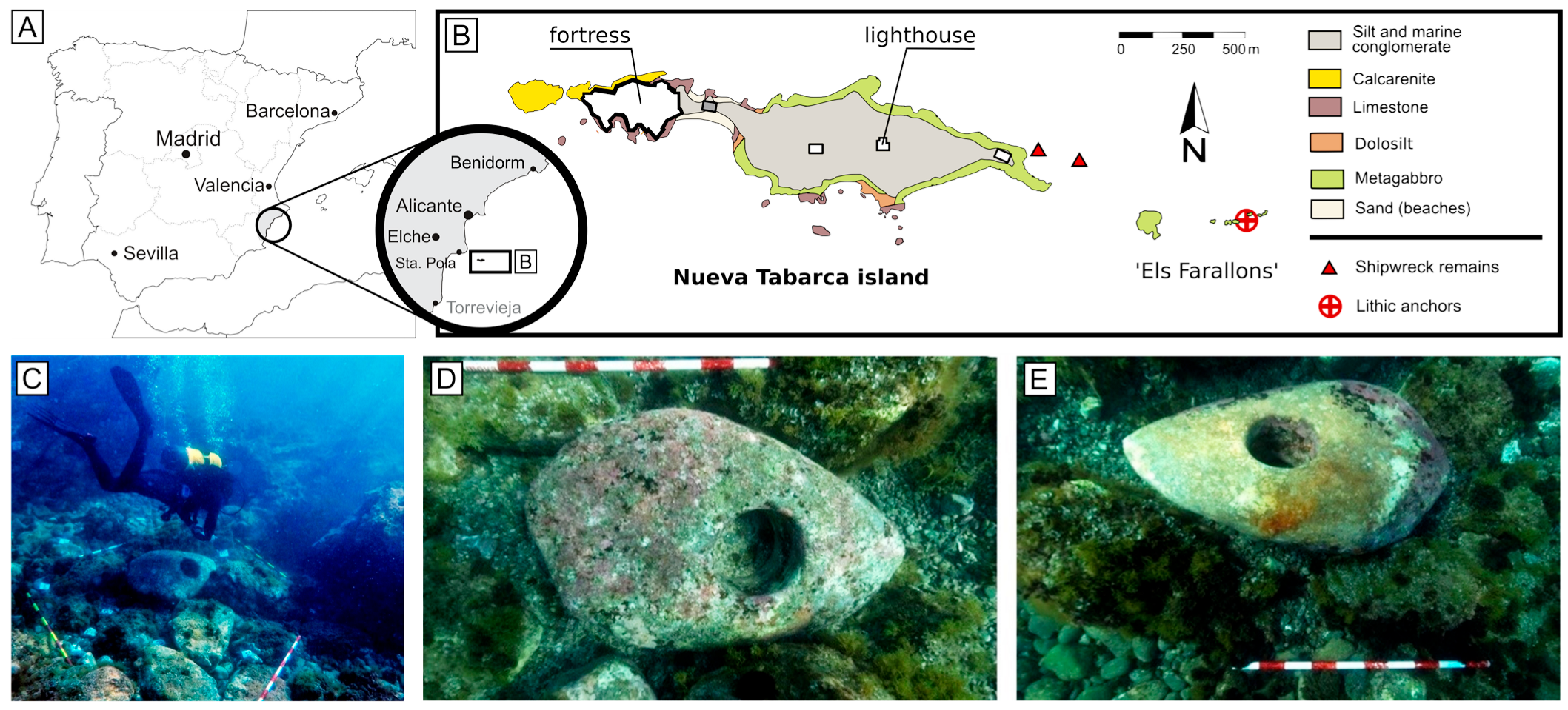


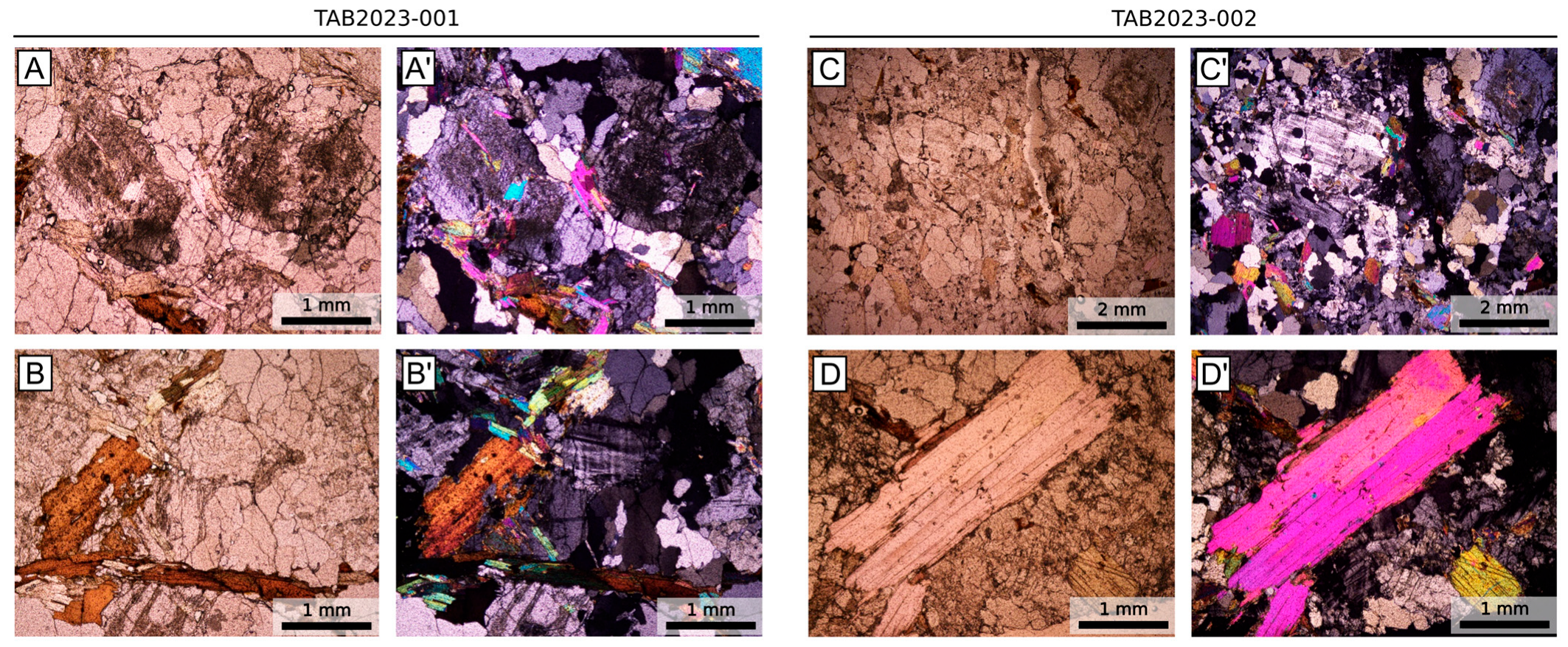
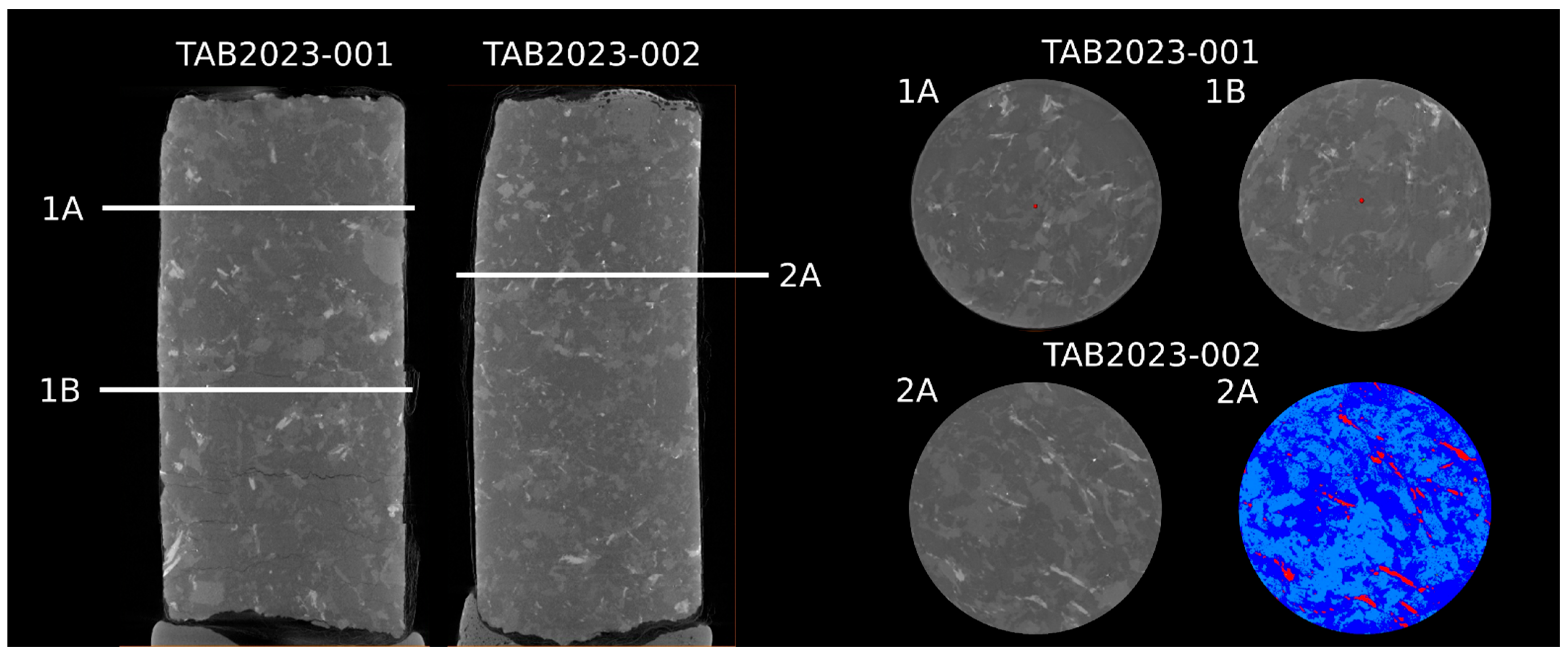

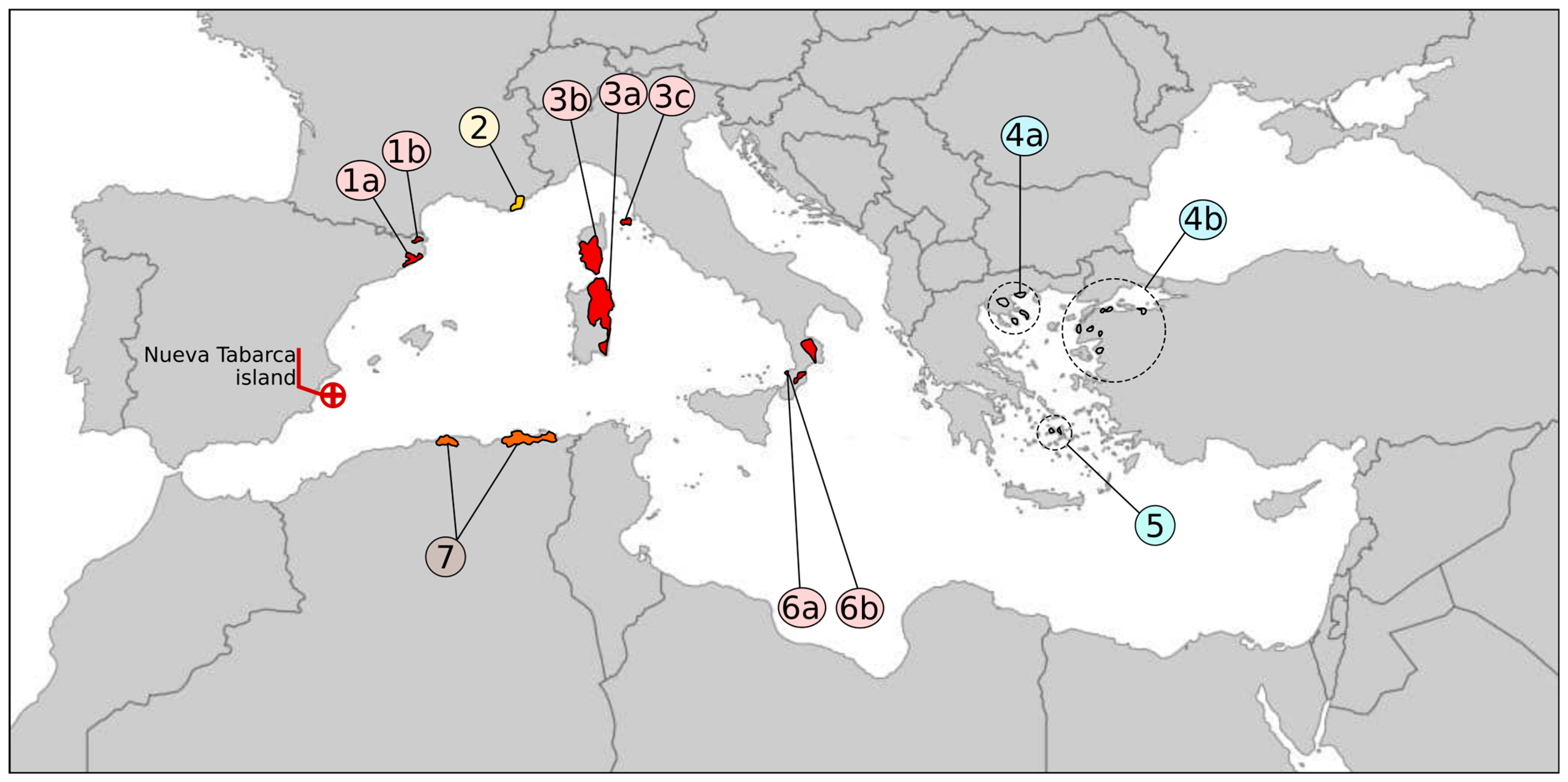

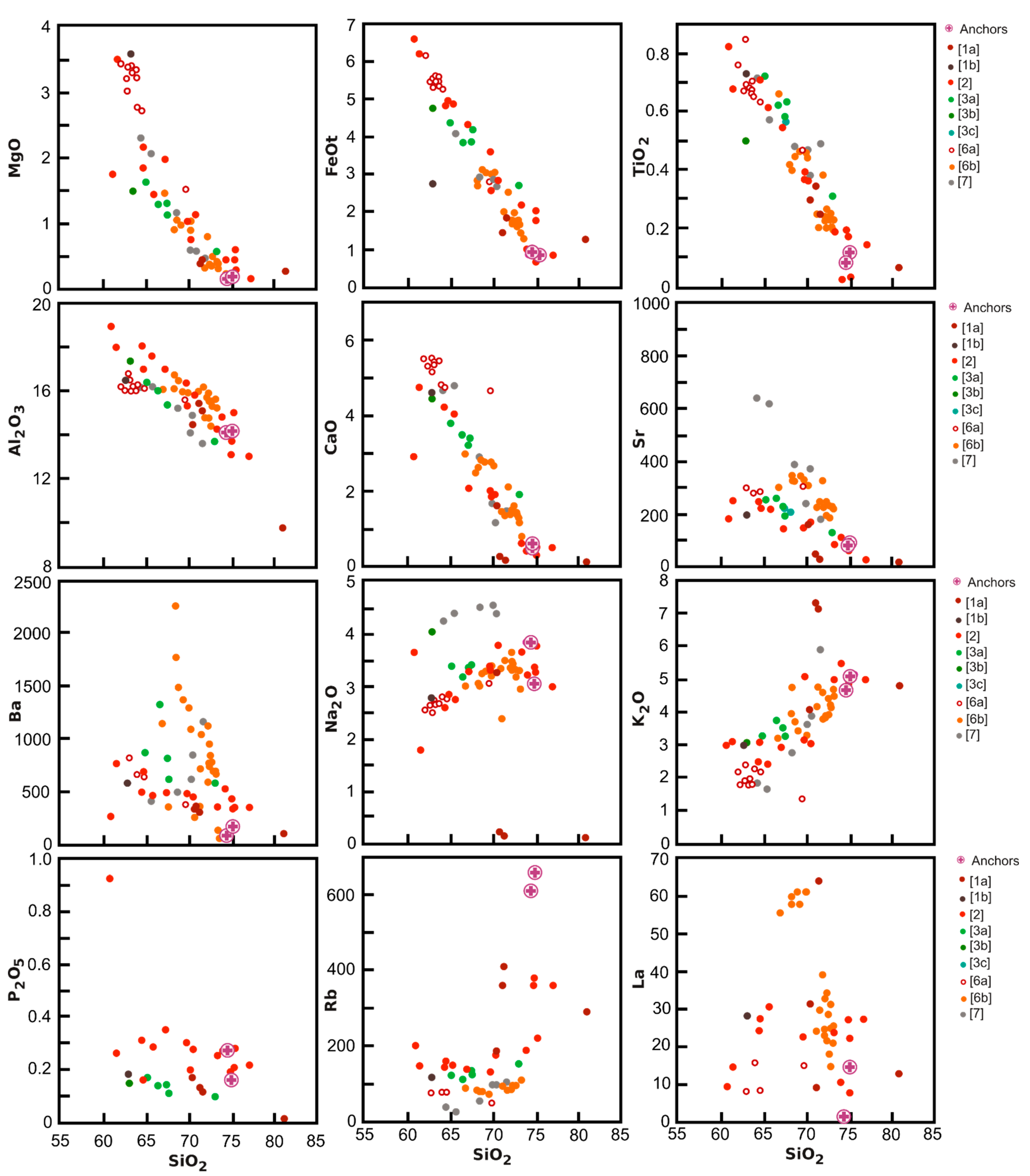
| SiO2 | TiO2 | Al2O3 | FeOt | MnO | MgO | CaO | Na2O | K2O | P2O5 | Ba | Ce | Pb | Ni | Rb | Nb | Y | Sr | V | La | Zn | Cu | Co | Sc | |
|---|---|---|---|---|---|---|---|---|---|---|---|---|---|---|---|---|---|---|---|---|---|---|---|---|
| [%] | [%] | [%] | [%] | [%] | [%] | [%] | [%] | [%] | [%] | ppm | ppm | ppm | ppm | ppm | ppm | ppm | ppm | ppm | ppm | ppm | ppm | ppm | ppm | |
| TAB2023-001 | 74.5 | 0.089 | 14.21 | 0.971 | 0.036 | 0.199 | 0.55 | 3.869 | 4.698 | 0.274 | 127 | <17.0 | 37.9 | <17.0 | 619 | <17.0 | 6.3 | 94.5 | <3.0 | <8.0 | 86.5 | 36.9 | <3.0 | 2.3 |
| TAB2023-002 | 74.97 | 0.121 | 14.21 | 0.868 | 0.031 | 0.22 | 0.653 | 3.127 | 5.089 | 0.17 | 191 | 22.3 | 40.7 | <17.0 | 660 | <17.0 | 4.3 | 98.3 | 3.7 | 15.3 | 99.7 | <13 | <3.0 | 2.6 |
| Sample | Mass | K Content | Total 40Ar | Radiogenic 40Ar | K-Ar Age |
|---|---|---|---|---|---|
| [mg] | [g/g] | [mL/g] | [mL/g] | [My] | |
| TAB2023-001 | 35.3 | 0.033 | 1.54 × 10−6 | 1.50 × 10−6 | 296 |
| TAB2023-002 | 27.6 | 0.033 | 0.88 × 10−6 | 0.86 × 10−6 | 228 |
| Area | Name | Petrological Description | Main Mineralogy | Age | References |
|---|---|---|---|---|---|
| 1a | East Pyrenees | Monzogranite with Fds-phenocrystals | Q>Fds[Mc]>Bt>(Ms) | 285–302 Ma | [30,31] |
| 1b | Cap de Creus | Medium-coarse grained granodiorite | Q>Pl>Fds[Mc]>Bt>Hrn | 294 Ma | [31,32] |
| 2 | Saint-Tropez | Equigranular granite (c. 0.5–1cm). Isotropic. | Q>Pl>Fds[Ort]>Bt | 325–290 Ma | [32,33] |
| 3a | Sardian Granite | Equigranular granodiorite. | Q>Pl>Fds[Orth]>Hrn>Bt | 320–280 Ma | [26] |
| 3b | Corsican granite | Granodiorite | Q>Pl>Fds[Mc]>Hrn>Bt | 320–280 Ma | [34] |
| 3c | Elba-Giglio granite | Medium-coarse grained monzogranite | Q>Fds>Pl>Bt | 7–5 Ma | [26,34,35] |
| 4a | Sandanski | Granodiorite | Q>Pl>Fds>Bt | ~20 Ma | [34] |
| 4b | Aegean | Medium grained granodiorite | Q>Pl>Fds>Bt>Hrn | ~20 Ma | [26,34,35,36] |
| 5 | Naxos | Porphyritic granite | Q>Pl>Fds>Hrn>Bt | 13–10 Ma | [37] |
| 6a | Nicotera | Two-mica medium-coarse grained granodiorites | Q>pl>Fds[Mc]>Bt>Ms | ~300 Ma | [29] |
| 6b | Parghelia | Two-mica medium-coarse grained granodiorites | Q>pl>Fds[Mc]>Bt>Ms | ~300 Ma | [29] |
| 7 | Beni-Snouss | Monzogranite. Porphiritic (Fds-phenocrystals). | Q>Ft>Pl>Bt | 300–290 Ma | [38] |
Disclaimer/Publisher’s Note: The statements, opinions and data contained in all publications are solely those of the individual author(s) and contributor(s) and not of MDPI and/or the editor(s). MDPI and/or the editor(s) disclaim responsibility for any injury to people or property resulting from any ideas, methods, instructions or products referred to in the content. |
© 2025 by the authors. Licensee MDPI, Basel, Switzerland. This article is an open access article distributed under the terms and conditions of the Creative Commons Attribution (CC BY) license (https://creativecommons.org/licenses/by/4.0/).
Share and Cite
Martínez-Martínez, J.; Corbí, H.; Fusi, N.; Molina Vidal, J.; Moya-Montoya, J.A.; Lorrio, A.J.; Lozano Quijada, F.; Pérez Burgos, J.M. Multiproxy Petrological Analysis for Provenance Determination of Two Granitic Stone Anchors in the Western Mediterranean. Minerals 2025, 15, 675. https://doi.org/10.3390/min15070675
Martínez-Martínez J, Corbí H, Fusi N, Molina Vidal J, Moya-Montoya JA, Lorrio AJ, Lozano Quijada F, Pérez Burgos JM. Multiproxy Petrological Analysis for Provenance Determination of Two Granitic Stone Anchors in the Western Mediterranean. Minerals. 2025; 15(7):675. https://doi.org/10.3390/min15070675
Chicago/Turabian StyleMartínez-Martínez, Javier, Hugo Corbí, Nicoletta Fusi, Jaime Molina Vidal, José A. Moya-Montoya, Alberto J. Lorrio, Felio Lozano Quijada, and José Manuel Pérez Burgos. 2025. "Multiproxy Petrological Analysis for Provenance Determination of Two Granitic Stone Anchors in the Western Mediterranean" Minerals 15, no. 7: 675. https://doi.org/10.3390/min15070675
APA StyleMartínez-Martínez, J., Corbí, H., Fusi, N., Molina Vidal, J., Moya-Montoya, J. A., Lorrio, A. J., Lozano Quijada, F., & Pérez Burgos, J. M. (2025). Multiproxy Petrological Analysis for Provenance Determination of Two Granitic Stone Anchors in the Western Mediterranean. Minerals, 15(7), 675. https://doi.org/10.3390/min15070675









